The Eukaryotic cell cycle 1: LECTURE 2
1/61
Earn XP
Description and Tags
(basic principles of master regulators
Name | Mastery | Learn | Test | Matching | Spaced |
|---|
No study sessions yet.
62 Terms
Steps for proliferating cells
cell growth
chromosome segregation
cell division
But these events must be
in the correct order
non-overlapping temporal compartments
How they figured out that DNA synthesis occurred in discrete interval in interphase
studied populations of meristmatic cells
for P32 uptake in the nucelus
results:
DNA synthesis began 12 hours from end of division
synthesis took 6 hours
entry into prophase another 8 hours
Conclusion from this
Cell cycle consists of
Pre-S-phase (Gap1)
S phase (period of DNA synthesis)
pre-mitotic (Gap 2)
cell division
HOw do human cells proliferate
duplicate in 24 hours
last 1 hour is for M phase
segregates chromsomes
contractile cytokinesis ring
Cell growth vs stepwise processes
Cell growth is continuous
syntehsis of new ribosomes
membranes
ER
most cellular proteins
Step wise processes
only happen once
DNA replication, centrosome duplication, chromosome segregation
The eukaryotic cell cycle
Growth 1:
Gap 1
Chromosomal replication:
S phase
Growth 2:
Gap2
Chromosomal segregation:
M phase
Why are there two growth phases inbetween
Growth phases are in between the S and the M to prevent the clashes and make sure the growth is a continuous process

How is cell cycle controlled?
Respond to
External cues:
signals, nutrients
Internal cues
‘ has critical size been reached?’
‘are chromosomes fully replicated and intact?’
Can also exit and return to different signals
exit: terminally differentiated cells
exit but return: repair tissue damage or replenish a specific cell pool

Research 1 into finding info about the cell cycle regulation:
Cell fusion experiments
Outline of the experiments
Cell at different stages of the cell cycle
pre-synchronised
fused together
to form heterokayrones
see what cycle phase they went into next
Experiment 1: Mitotic cell + any interphase cell
Observation:
heterokayons interphase nuceli forced into nuclear envelope breakdown
condense their chromsomes
Conclusion:
M phase state was dominant over all other states
must contain active factor
which direct cells to go straight into mitotic state
Experiment 2: S phase and G1 phase cell
Observation 1:
G1 nucleus began DNA replication
Conclusion:
Presence of S phase inducer
shared by the S phase cell upon fusion
Observation 2:
heterokayron could not enter M phase until G1 nucleus completed replication
Conclusion:
feedback control that prevents a cell engaged in ongoing DNA replication to proceed into M
Experiment 3: S phase + G2 cells
Observation:
S phase nucleus continued replication
G2 could not induced S nucleus to start DNA replication
Conclusion:
must be a block to re-replication
after completetion of DNA replication in the given cycle
Limitation with this research
Hinted at a molcular factor that induced things going into mitosis
but
provide no way forward in finding these molecules that were repponsible
no insight into the coordination between continuous stepwise processes
Conclusion of this research
mitotic state is dominant over all interphase states
Dependency relationships restrict events to occur only once per cell cycle
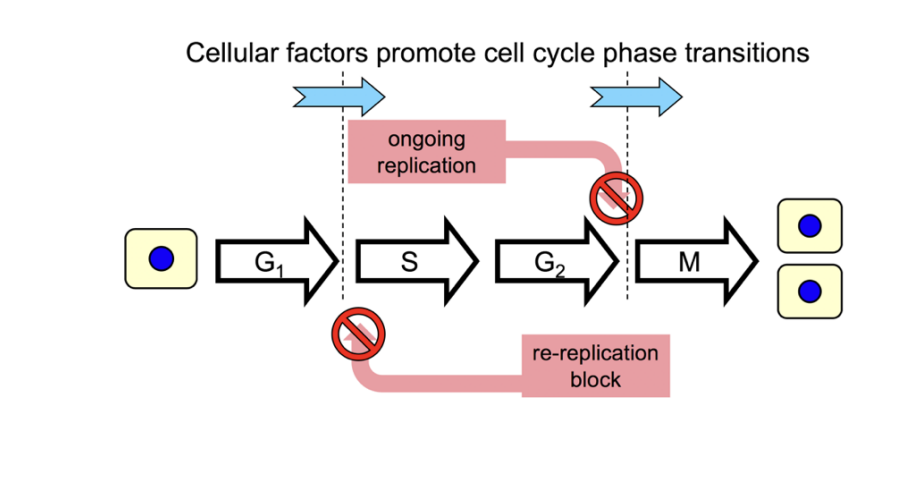
To help get a deeper dive into the molecular control- look at different cell cyles
Early embryonic cell cycle
Somatic cell cycle
Early emrbyoninc cell cycle features
specialised for rapid and synchronous cell division without cell growth
rounds of DNA replication alternate with rounds of chromosome segregation
what cell it forms?:
smaller cells in successive cell cycles
Stop points?
natural arrest points and synchronous division
may be exploited
How can they do this?
massive maternal stockpiles of cellular transcripts and factors
promote fast cell divisions
cleaving embryo
Popular model for embryonic cells
frog eggs
marine invetebrate eggs
fruit fly syncytial embryo
The somatic cell cycle features
Canonical cell cycle: G1, S, G2, M
Control?
prominent control of these stages
can be synchronised by drugs
What cells form?
cell size homeostasis is reached
due to cells cooridanted growth and division
Models for somatic cell division:
Most other cells other than embryonic
Also:
fission and budding yeast
INn fission and budding yeast
Morphology may be correlated with cell cycle position
(right = fission yeast)
Left = fission yeast= bud emergence is an important landmark
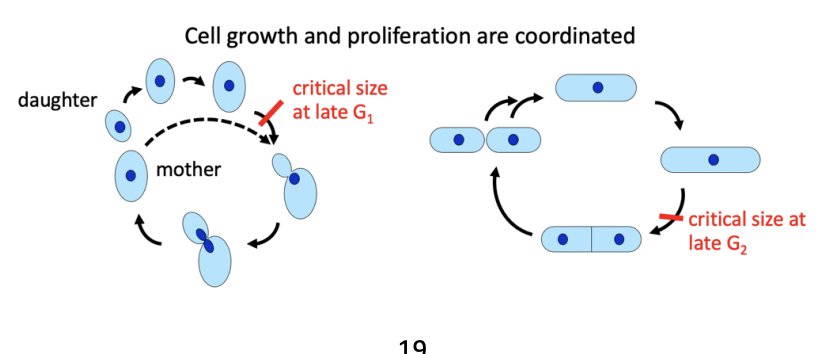
TO distinguish stages of the animal cell cycle
New markers developed in recent years:
distinguish cells through interphase
not morphological markers
These two cell cycles can be used to investigate different things
Biochemical approach
identify activities that correlate with M-phase state
Genetic approach
mutations that block the cell cycle without affecting cell growth
Both used to ultimately find the master regulator of the eukaryotic cell cycle
Wht to use for the Biochemical approach
Embryonic Cell Cycle:
Why?
specialised for rapid and synchronous division
(exhibiting natural blocks)
Easy to purify
east to characterise
can be induced to divide syncrhonously
can easily be microinjected
How used?
time course analysis of extract for activities driving cells into M phase
easy to characterise and purify
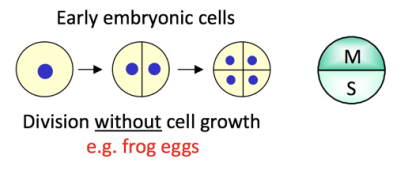
What cycle type if used for the genetic approach
Somatic cell cycle:
Why?
genetically tractable
cells displaying prominent control points
so lots of control points to explore and find the genetics/ proteins invovled!
How used?
screen for mutants that disable transit across control points
isolate corresponding genes
by complementation
quite easy!
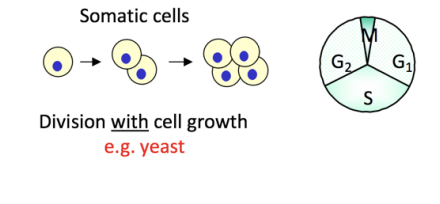
Research 2: Biochemical experiments with Frog eggs- how do the cells divide?
INn meiosis
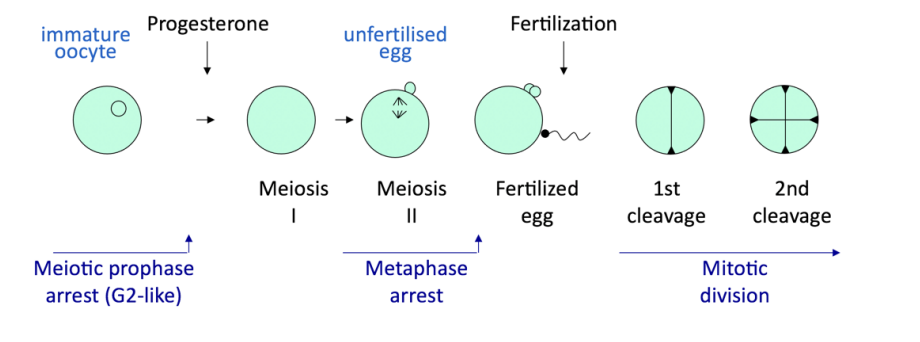
Finding the activity that correlate with the M-phase state
Experiment
transferred from cytoplasmic contents from mature oocytes into immature oocyctes
the mature oocyctes has matured coz they were injected with progesterone
Observation:
drove maturation of the immature oocytes
Conclusion:
a factor from the donor oocyte forced the transition into meiosis
even without the progesterone!
But just to check you havnt just tranferred the injected progestrone from before:
Repeat many times to more immature oocytes
RESULT: still matured the cells!
Overall conclusion
component that promotes maturation was from donor egg
NOT from carry-over of progestrone
This activity was called maturation promoting factor
Maturation promoting factor (MPF)
induces oocyte maturation (meiodid) even if protein synthesis is blcked
ALSO induces mitosis in fertilised eggs
DESPITE being blocked in interphase by protein synthesis inhibitors
Link between past cell fusion experiments?
MPF dominant activity similiar to the ‘dominant state’ of the M Phase from fusion experiments
What was needed to assay the MPF activity
cell-free system was developed
possible to undertake its purifation and eludicate its composition!
Research 3: Trying to find the components of the MPF
Experiment:
Fertilized eggs + 35S-methionine
sampled at set intervals
Anaylsed the patterns of radiolabbeled proteins being made
Results:
Most proteins increased continuously
consistent with continuous growth
BUT: ‘cyclin’ behaves differently
disappreaed at the end of each mitosis
reappeared during the next interphase A
Conclusion:
Matched the activity of MPF
cyclin must be a component or activator of MPF
destruction of cyclin leads to M phase exit
Research 4: Actually trying to find thse components: Genetic approach
Using somatic cells!
Features of yeast somatic cell cycles for this research
Budding yeast:
critical size: at G1
Fission yeast
Critical size at G2
These features can be used to easily find know which stage the yeast is at in the cycle.
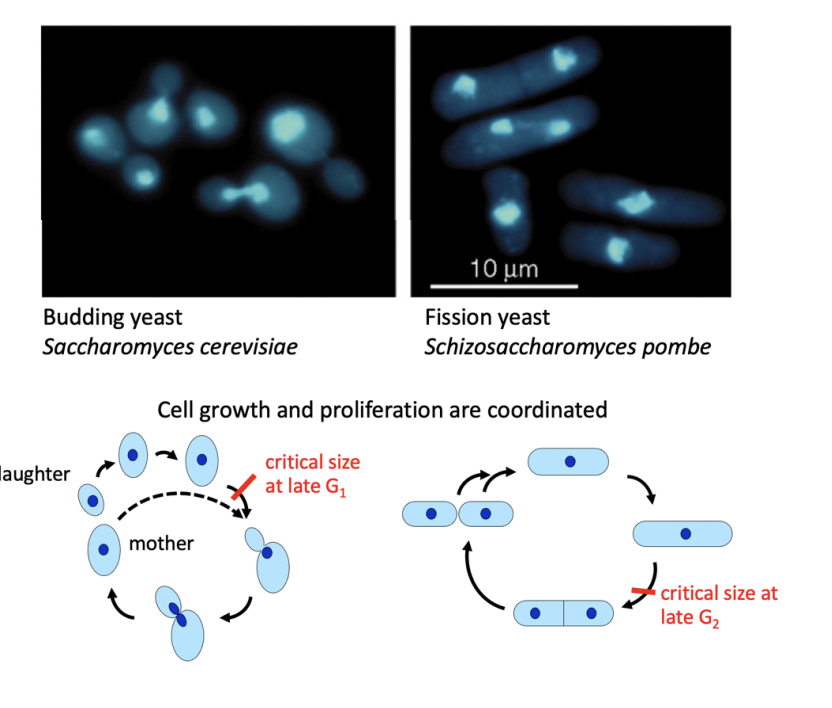
Why budding yeast is useful to use
easy to isolate mutants
easily find corresponding genes
model for somatic cell cycle control
morphology (see last slide)
diagnostic of the position in cell cycle

what is the START of the cell cycle in late G1 of budding yeast?
Decide between proliferation or arrest
point of no return in the cell cycle
(conditions only evaluated again in the subsequent cycle at START)
Dependent on?
Various cues
Critical size reached
What is triggers?
Bud emergence
convenient morphological marker
indicating the cells have gone past this control point
Various cues: divide mitotically
Nutrients
size
→ divide mitotically
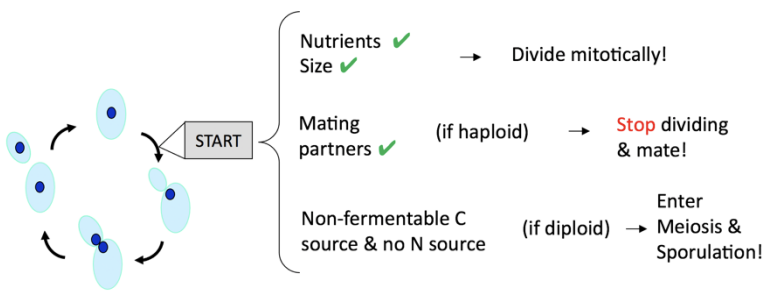
Various cues: stop dividing and mate
Mating partners
if diploid
→ stop dividing and mate
Various cues: enter meiosis and sporulation
non-fermentable carbon source
no Nitrogen source
if diploid!
→ enter meiosis and sporolation
Why are isolated mutants used to find out about the cell cycle
Essential functions can be identified genetically
By screening for conditional mutants
e.g temperature sensitive mutants
What temperature sensitive mutants do
generally encode gene products that are
Active @→ permissive temperature
Inactive @→ restrictive temperature
cdc mutants
cell division cycle mutants
isolated and characterised independently first in
first in budding yeast
then in fisssion yeast (pombe)
Why are cdc mutants useful
Arrest with uniform morphology at restrictive temperature
i.e can see exactly at which part of the cell cycle the mutant is affecting
e.g cdc20ts
at first asynchronous proliferation at
at permissive temperature
shift to restrictive temperature
arrest with uniform morphology
each cell reaching the point of the block
due to mutant (e.g cdc20ts)
unable to to proceed past it
really useful just to change temperature to see a change
easy to see that the protein the gene encode is for

(research 4): How used to find out about START
many different cdc mutants characterised
functional map of which parts of the cycle they affect
found that cdc28ts→ Prevents cells from proceeding past START
at the restrictive temperature
What this means?: the CDC28 gene product must be needed for START
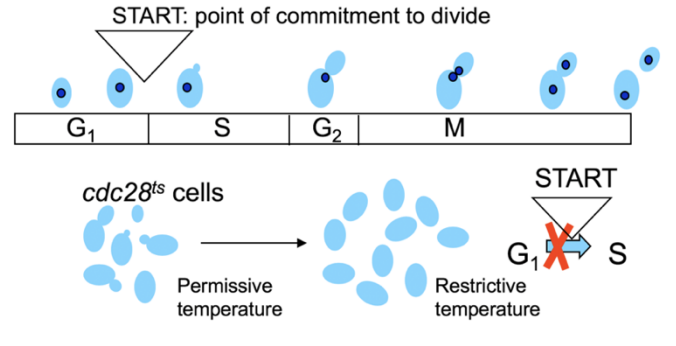
Finding the protein once the gene was found (CDC28ts)
CDC28 cloned by complementation
bit like DNA fingerprinting?? or probe thingy?
Found it codes for ~34kDa protein
similar to protein kinases
Ser/Thr Kinase activity was demonstrated
How CDC28 isolated by complementation
Take the cells which have the mutants
These cannot proliferate at restrictive temperature
Transform with a yeast genomic library
plasmid mix with random inserts of yeast genomic DNA
Grow on restrictive temperature
The ones that can grow must be the ones that have receieved a CDC28 plasmid (which we don’t really know yet!)
Take these cells and analysis which plasmid they got
Sooo now we know which gene the mutant had come from
Can now try figure out what this gene encodes
So now we know a bit more about the START
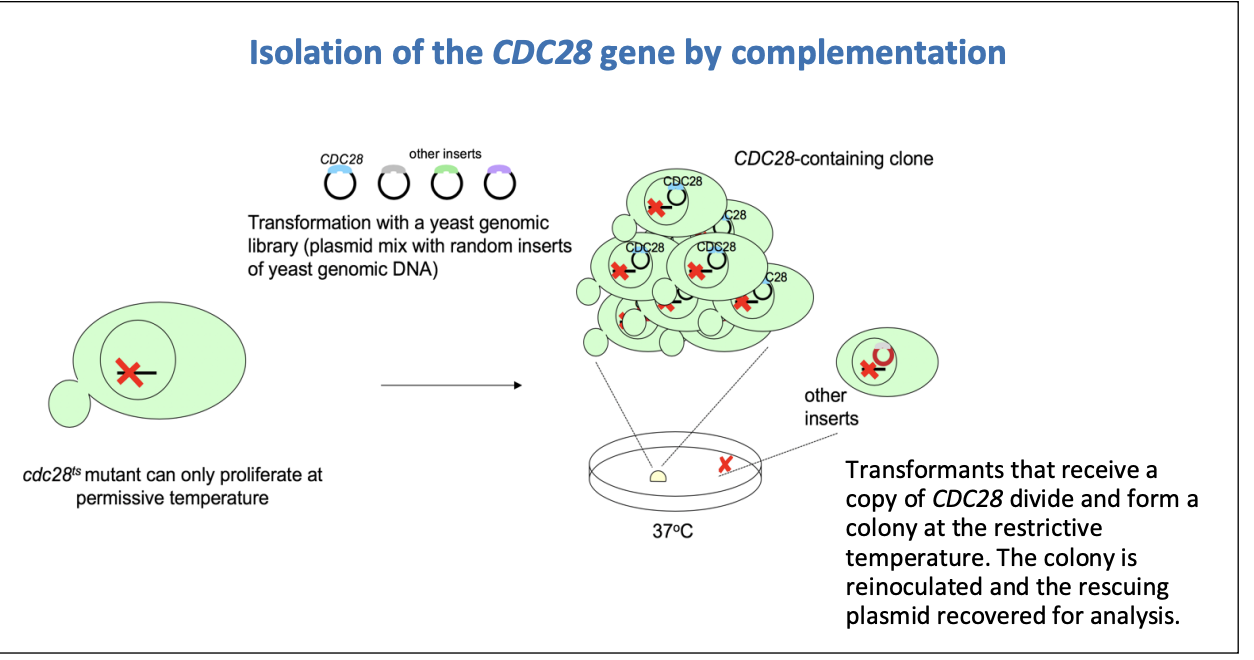
How are fission yeast useful for studying the cell cycle
rod-shaped cells
grow in length
divide symmentrically
BUT: no morpholigcal marker to show START progression
must reach critical size instead at M phase
→ so very useful in finding out about the M phase transition point!
Two mutants found to affect M phase transition
wee1
cdc2ts
What does wee1 tell us?
Mutant→ cells divide at smaller size
So M phase must be starting sooner
Before it has grown to critical size
incorrect timing
THEREFORE:
wee1 gene must code for something that ensures the cell waits till grown
i.e stops the M phase progressing
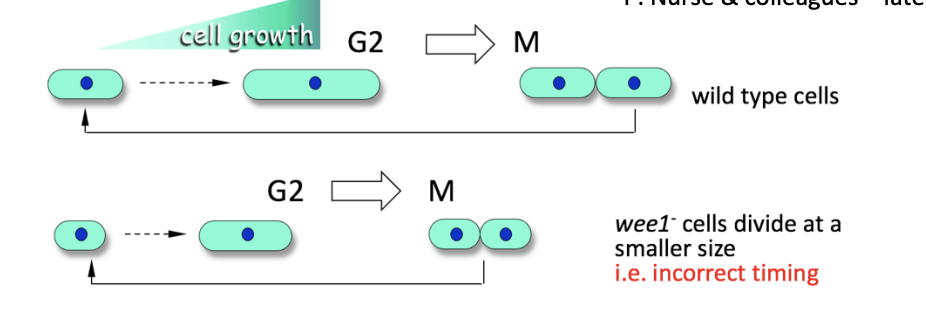
What does the cdc2ts mutant tell us
@ restrictive temperature
M phase is blocked
BUT
Continues to grow
Become very long cells
THEREFORE: cdc2 is essential for progression into M phase
protein is essential for mitotic entry

Interaction of cdc2 and wee1
Wee1 is an inhibitor of cdc2
coz cdc2 wants M phase
but wee1 stops it
In wee1- mutant: cdc activation is advanced
cells really want to go into M phase
What about the START in fission yeast (pombe?)
Found that cdc2+ in pombe corresponds to the CDC28 in cerevisiae (budding)
THEREFORE:
cdc2+ is needed for START and M phase in fission yesat
cdc2+ and CDC28 and functional homolgoes
can replace CDC28 with cdc2+ and vise versa
What about in humans?
CDC2Hs
Human homologue
identified by screening a human cDNA expression library
in an S.pombe cdc2ts mutant
What this shows
Budding and fission yeast are as evolutionary apart from eachother
as much as yeast from humans
OVERALL protein p34 from both these genes
A key cell cycle regulator
CONSERVED throughout evolution
NOW: how to link these gene protein products to the MPF we have already found (linking biochemical and genetic approaches)
Cdc2
Antibodies raised against cdc2 cross-react MPF
Found: crosses with the 32kDa subunit of MPF
therefore cdc2→ 32kDa polypeptide
Cyclin B
corresponded to 46kDa polypetites
What have we overall found about MPF
Prototype of an evolutionary conseved family of:
Ser/Thr protein kinases (‘cyclin dependent kinase (CDK)’)
CDK are made of
Cdk: catalytic component
Cyclin: regulatory component
THERFORE: MPF = CDK (cyclin-dependent Kinase)
How do Cdk and cyclin interact
cyclin binds to the Cdk
cyclin activates cdk
controls its temporal and spatial function
forms a kinase
phosphorylates the stuff for M phase
S and T residues within the [S/T]PX[K/R sites
this substrate specificity is controlled too!
cyclin is phosphorylated with phospatases
Cyclin GONE→ no more M phase
THEREFORE: regulation
![<ol><li><p>cyclin binds to the Cdk</p><ul><li><p>cyclin activates cdk</p></li><li><p>controls its <strong>temporal </strong> and <strong>spatial</strong> function</p></li></ul></li><li><p>forms a kinase</p></li><li><p>phosphorylates the stuff for M phase </p><ul><li><p>S and T residues within the [S/T]PX[K/R sites</p></li><li><p>this substrate specificity is controlled too!</p></li></ul></li><li><p>cyclin is phosphorylated with <strong>phospatases</strong></p></li><li><p>Cyclin GONE→ no more M phase</p></li></ol><p>THEREFORE: regulation</p><p></p>](https://knowt-user-attachments.s3.amazonaws.com/ff6be2ae-0753-4e1b-a89c-10f541adb651.png)
How does cyclin regulate cdk
activates cdk
controls temporal and spatial function
influences CDK substrate specificity!